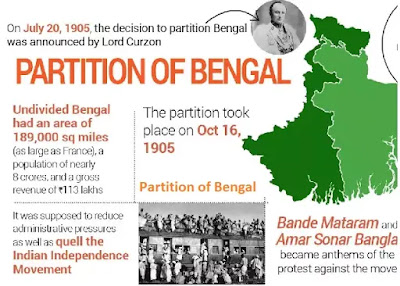Partition of Bengal
United Bengal’s area covered 189,000 sq. miles with an 80 million population. It was very inefficient of the administration to control the very big area effectively. Since It had an 80 million population, it almost impossible for the authorities to effectively and efficiently administrate the area. In 1900 a viceroy named Lord Curzon started dividing the areas into units for administrative reasons. In 1905, he also divided The Bengal into two units: east and west Bengal. Muslims were very happy because out of luck in the east part Muslims were in great number. While on the other hand, it was very indigestible for Hindus, for they couldn’t see an additional Muslim province and they are seeing this as a big sin because the division of land is against their religious beliefs. Therefore, Hindu showed agitation against this reform and went on strike. Muslims were about to take a sigh of relief and then they saw Hindu's anger over the partition of Bengal. To avoid trouble on the visit of King George V, the British in 1911 revoked the partition of Bengal. The Muslims were disappointed by the government's response to the violent strategy of protests adopted by the Hindus.
 |
Partition of Bengal
The Simla Deputation 1906
A sense of political interest was developing amongst the Muslims during that time. Muslims thought they must stand up to protect their rights and unless they do that objectives would not be achieved. Therefore, an organized and systematic attempt was made to present the demands to the British government, and that attempt was named Simla Deputation. The Simla deputation comprised 35 Muslims from all over India. It was a galaxy of Muslim leaders from all the provinces, from one end of India to the other and it had Muslims of all backgrounds. When in 1906, this deputation called on the Viceroy, it was the most complete representative Muslim delegation. This delegation was led by Sir Agha Khan and Nawab Mohsin ul Malik served as a secretary and this delegation met the Viceroy in Simla which was why it was called as Simla Deputation. The delegation asked the British to not look at Muslims in numerical terms but in terms of the historical importance of Muslims. They told the contribution that Muslims had made to the British. They also made a statement that Muslims are different in values and culture and Hindus are different. Taking this thing into account, there was some important demand in Simla Deputation and those are:
Separate electorate
Representation more than their population because of their importance.
Reservations of Muslim seats in government jobs.
Special share in Municipal or district boards University senates and syndicates
Muslim representation in Viceroy Executive Council.
Muslim University at Aligarh.
The Viceroy was sympathetic towards the demands. It encouraged the Muslims to launch a struggle for their rights parallel to the Indian National Congress but it required an organized platform.
Formation of Muslim League in Dhaka: December 30, 1906
The Muslim leaders desired to create a permanent political forum. After the meeting of the Mohammedan Educational Conference, the Muslim leaders met to set up the All India Muslim League. Wiqar-ul-Mulk chaired the meeting. Nawab Salimullah proposed Muslim League and Hakim Ajmal Khan and Maulana Zafar Ali Khan seconded. In the Karachi session Dec. 1907 its constitution was approved and in March 1908 at Aligarh, Agha Khan was formally elected its president
GOALS of Muslim league:
Protection and promotion of political rights and interests of the Muslims.
Cooperation with other communities without prejudice to the above goal.
Fostering a sense of loyalty, among the Muslims, towards the government.
Change in the Goals of the Muslim League 1913 and Quaid-i-Azam joined Muslim League
The first decade of the 20th century had some harsh development like the annulment of the Partition of Bengal and Western aggression towards Muslim countries, Balkan wars, Libya-Italy war, Demolition of the mosque in Kanpur (1913), etc. weakened Muslim faith in the British. This led to a major change in the Muslim League’s policy. In 1913, the League changed
its goals:
Self-government under the British Crown keeping in view the peculiar conditions in India.
Good relations with other communities’ cooperation with any party working for similar goals.
This change brought the ML and Congress closer. In this way, the era of cooperation between Hindus and Muslims set in. The role of the Quaid-i-Azam is highly noteworthy to bring the Congress and the Muslim League to the table. He joined the Muslim League in 1913.
Lucknow Pact, 1916
The Lucknow pact was the product of Hindu-Muslim unity. In December 1915, the ML and Congress met separately in Bombay. Both the parties set up committees for making a scheme for constitutional changes in consultation.
Jinnah did a lot to unite the two nations along with the acceptance of the rights of Muslims.Meeting of both parties held at Lucknow in 1916. The constitutional proposals were approved:
One-Third seats for Muslims in the Imperial Legislative Council.
Separate Electorate
Half members of the Executive Council to be elected by the Imperial LegislativeCouncil.
Commissioned ranks of the army for Indians.
Muslims were happy because they had a Separate Electorate and One-Third Muslim seat in Central Legislature. In addition, the bill will be Unofficial, if opposed by three-fourth members of a community, and it will not be passed.






0 Comments